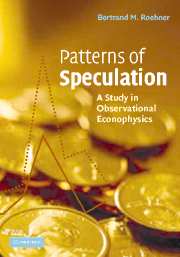Book contents
9 - THEORETICAL FRAMEWORK: IMPLICATIONS
Published online by Cambridge University Press: 02 December 2009
Summary
In the present chapter we explore a number of implications and applications of the theoretical framework delineated in the previous chapter. Several of these applications require a stochastic framework; nevertheless we will avoid technicalities as far as possible in order to keep this chapter in line with the rest of the book. As far as the more technical sections are concerned readers may, if they wish, jump directly to the conclusions without losing the gist of the argument.
In the first section we consider an application which, although very simple mathematically, has interesting consequences, which can be summarized a follows. During a speculative episode (for instance the bull market of 1920–1929) the higher the price of a stock climbed during the rising phase the better it resisted during the subsequent bear market. This regularity, which will be referred to as the resilience pattern, is not restricted to stocks but can also be observed for other items, such as stamps, houses, or apartments.
The second section is devoted to what the Boston group (Plerou, Amaral, Gopikrishnan, Meyer, and Stanley 2001) called the breakdown of scaling. If one considers the distribution of the logarithms of stock price changes δp(t, θ) = ln p(t) – ln p(t − θ) one observes that the width of the distribution remains constant (provided the differences are normalized by dividing them by the standard deviation σp) for θ comprised between a few minutes and one day; however, for θ comprised between two weeks and several months the width of the distribution decreases.
Information
- Type
- Chapter
- Information
- Patterns of SpeculationA Study in Observational Econophysics, pp. 198 - 215Publisher: Cambridge University PressPrint publication year: 2002
